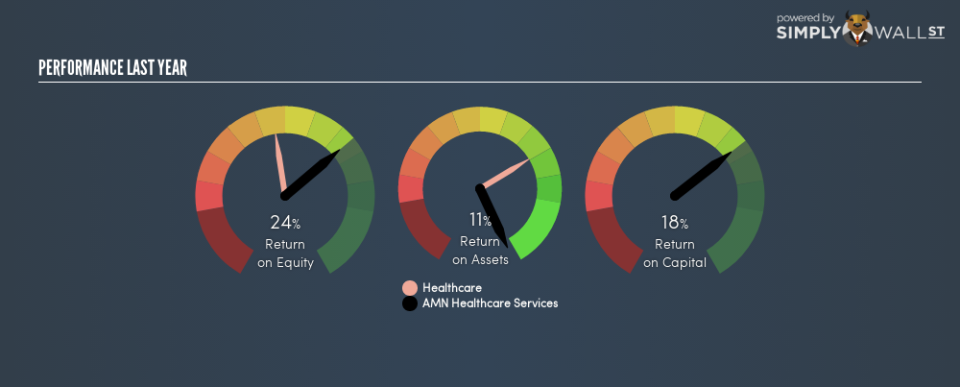Why AMN Healthcare Services, Inc.’s (NYSE:AMN) Return On Capital Employed Is Impressive

Today we are going to look at AMN Healthcare Services, Inc. (NYSE:AMN) to see whether it might be an attractive investment prospect. To be precise, we’ll consider its Return On Capital Employed (ROCE), as that will inform our view of the quality of the business.
First, we’ll go over how we calculate ROCE. Next, we’ll compare it to others in its industry. Finally, we’ll look at how its current liabilities affect its ROCE.
Return On Capital Employed (ROCE): What is it?
ROCE is a metric for evaluating how much pre-tax income (in percentage terms) a company earns on the capital invested in its business. Generally speaking a higher ROCE is better. Overall, it is a valuable metric that has its flaws. Author Edwin Whiting says to be careful when comparing the ROCE of different businesses, since ‘No two businesses are exactly alike.’
How Do You Calculate Return On Capital Employed?
Analysts use this formula to calculate return on capital employed:
Return on Capital Employed = Earnings Before Interest and Tax (EBIT) ÷ (Total Assets – Current Liabilities)
Or for AMN Healthcare Services:
0.18 = US$212m ÷ (US$1.5b – US$303m) (Based on the trailing twelve months to September 2018.)
Therefore, AMN Healthcare Services has an ROCE of 18%.
See our latest analysis for AMN Healthcare Services
Want to help shape the future of investing tools and platforms? Take the survey and be part of one of the most advanced studies of stock market investors to date.
Does AMN Healthcare Services Have A Good ROCE?
One way to assess ROCE is to compare similar companies. In our analysis, AMN Healthcare Services’s ROCE is meaningfully higher than the 13% average in the Healthcare industry. We consider this a positive sign, because it suggests it uses capital more efficiently than similar companies. Regardless of where AMN Healthcare Services sits next to its industry, its ROCE in absolute terms appears satisfactory, and this company could be worth a closer look.
Remember that this metric is backwards looking – it shows what has happened in the past, and does not accurately predict the future. Companies in cyclical industries can be difficult to understand using ROCE, as returns typically look high during boom times, and low during busts. This is because ROCE only looks at one year, instead of considering returns across a whole cycle. What happens in the future is pretty important for investors, so we have prepared a free report on analyst forecasts for AMN Healthcare Services.
What Are Current Liabilities, And How Do They Affect AMN Healthcare Services’s ROCE?
Current liabilities include invoices, such as supplier payments, short-term debt, or a tax bill, that need to be paid within 12 months. Due to the way ROCE is calculated, a high level of current liabilities makes a company look as though it has less capital employed, and thus can (sometimes unfairly) boost the ROCE. To check the impact of this, we calculate if a company has high current liabilities relative to its total assets.
AMN Healthcare Services has total liabilities of US$303m and total assets of US$1.5b. As a result, its current liabilities are equal to approximately 20% of its total assets. A fairly low level of current liabilities is not influencing the ROCE too much.
The Bottom Line On AMN Healthcare Services’s ROCE
Overall, AMN Healthcare Services has a decent ROCE and could be worthy of further research. You might be able to find a better buy than AMN Healthcare Services. If you want a selection of possible winners, check out this free list of interesting companies that trade on a P/E below 20 (but have proven they can grow earnings).
If you are like me, then you will not want to miss this free list of growing companies that insiders are buying.
To help readers see past the short term volatility of the financial market, we aim to bring you a long-term focused research analysis purely driven by fundamental data. Note that our analysis does not factor in the latest price-sensitive company announcements.
The author is an independent contributor and at the time of publication had no position in the stocks mentioned. For errors that warrant correction please contact the editor at editorial-team@simplywallst.com.


